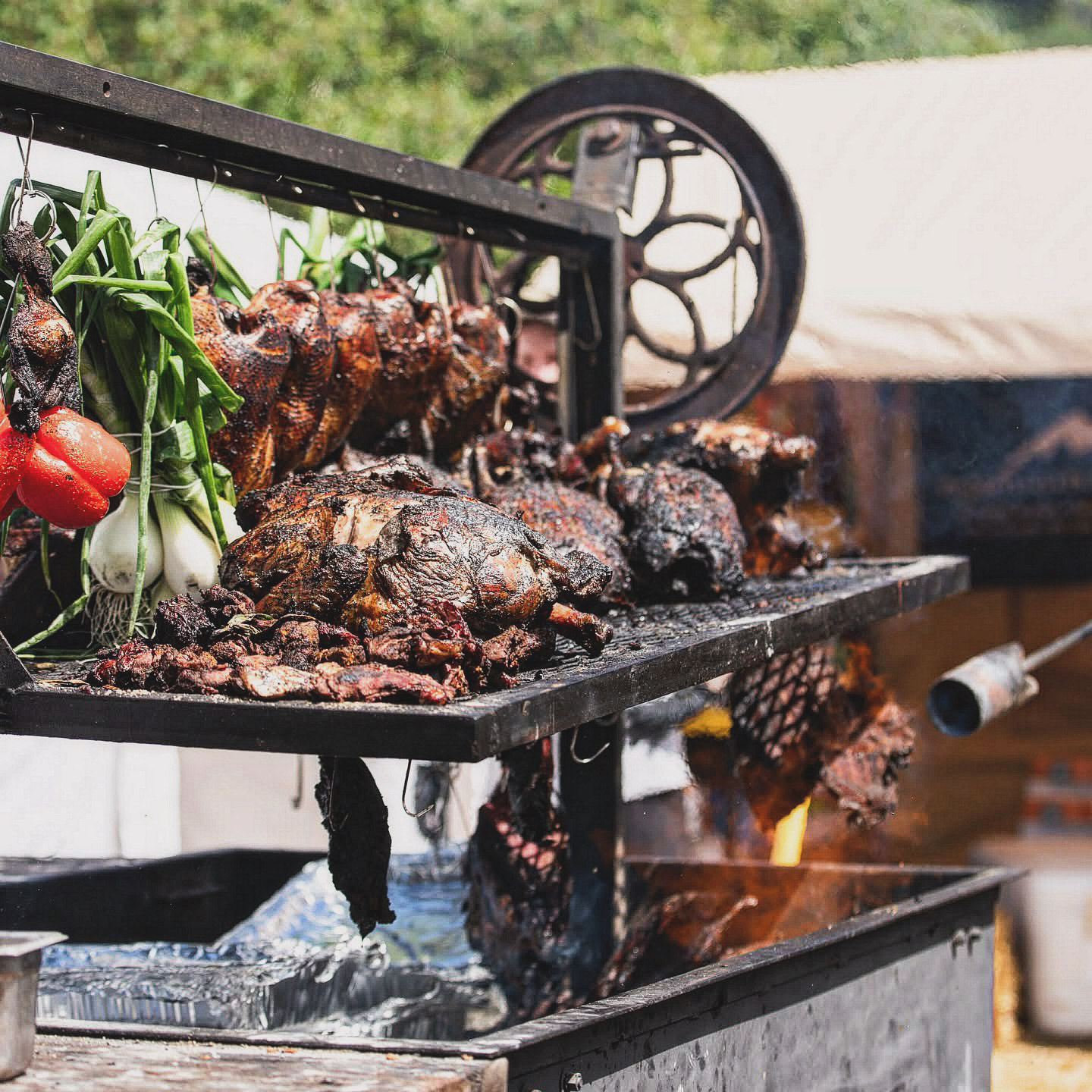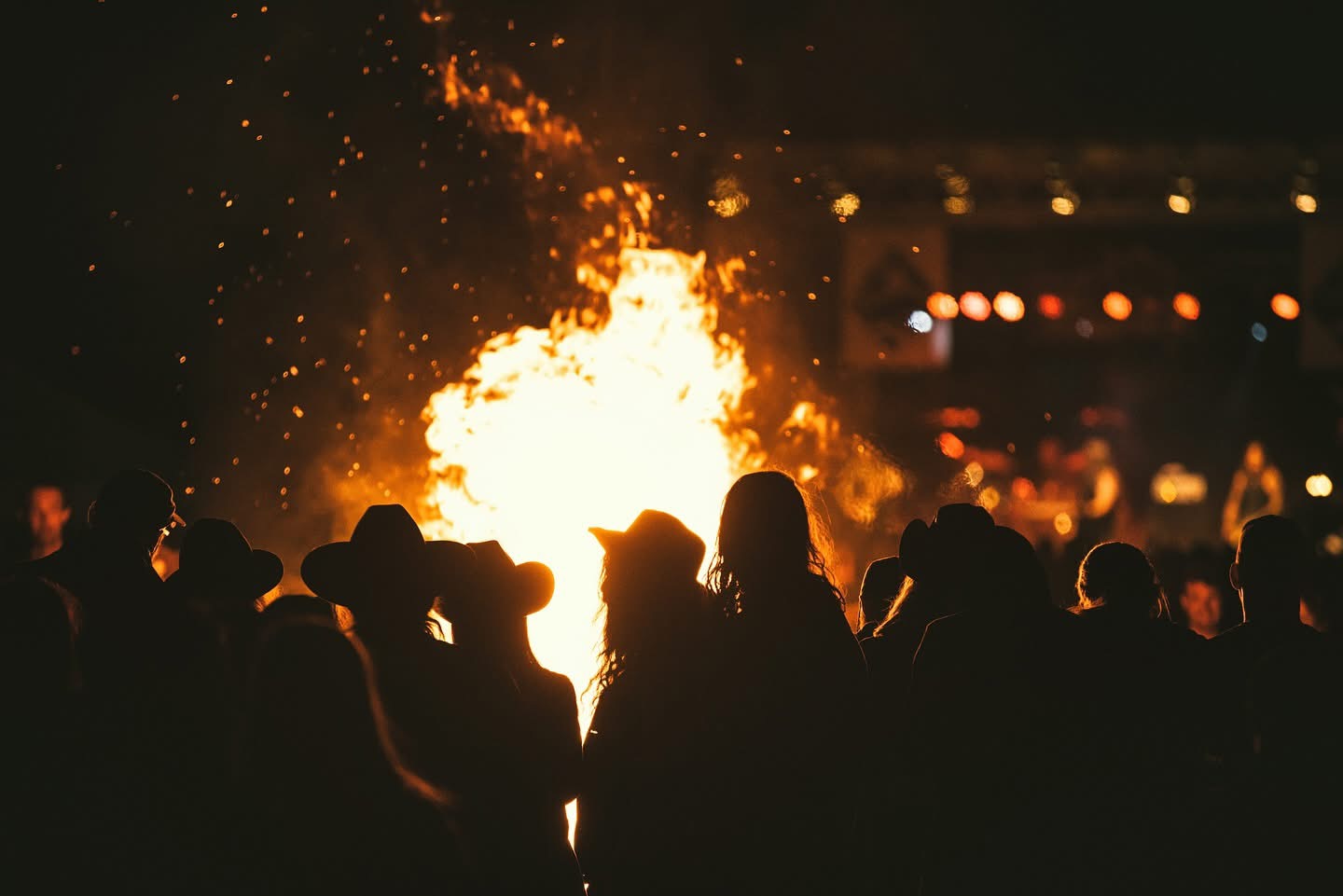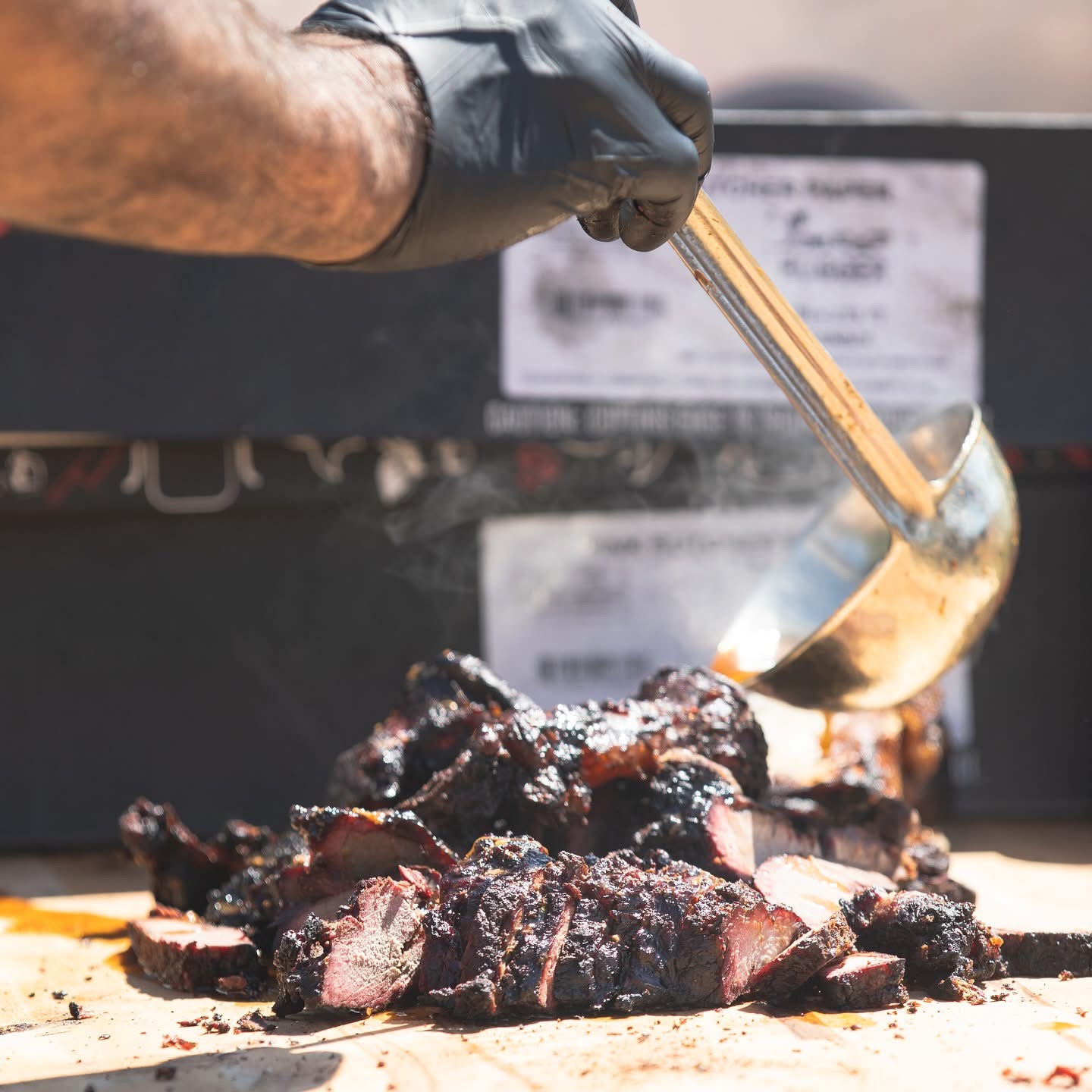
The Flavor of Fire
In the rain-washed air above Red Eagle Campground, vibrations of rock ’n roll power chords mingled with the fragrant smoke of a three-day buffalo feast, as clouds clung to the surrounding mountains at the headwaters of North America. On the ground, a mix of local Blackfeet Tribal members and head-bangers from around the world honed their appetites with heavy metal calisthenics at the three-day Fire in the Mountains Festival.
A well-appointed outdoor kitchen featured some heavy metal of a different sort. Several fire-breathing grilling apparatus imported from Argentina, where they know a thing or two about cooking large animals, were laden with heavy roasts of bison. The hunks of meat contorted in the rising smoke of cherrywood briquets, sputtering occasional geysers of sizzling juice at the hot framework. Bunches of onions hung in the smoke, while peppers, corn, beans, asparagus, potatoes, beets, turnips and other root crops, everything locally grown, browned closer to the coals.
“It was very welcoming and peaceful, and the no alcohol policy amplified this,” says Drew Iaderosa, an occupational therapist from Missoula. “It was the kind of festival that could turn a metal skeptic into a believer of the genre,” he said. Iaderosa described his favorite meal, a Philly-style buffalo cheesesteak sandwich, in a manner that cannot be printed.

The feast was structured like an asado, explained Tom Fitzgerald, owner/executive chef of the Whitefish catering company Region Sauvage, which fed the festival’s 1,200 guests. The word asado refers not only to the type of grill but also the style of whole-animal cookery where the different cuts are served at different times throughout the feast, based on when they reach perfection.
“Feeding the guests asado-style was the closest I could resonate to feeding Native Americans without trying to do it their way. It’s an American style, but far enough away to not intrude on their traditions,” Fitzgerald says.
Fitzgerald grew up in the remote North Fork Valley of the nearby Flathead river, and has traveled to similar temperate regions in other countries to better understand the culinary possibilities of home. While sourcing his grill game from down south, he’s looking to Norway and Japan for inspiration on fermentation. These techniques are useful for preserving foods without modern sterilization techniques, and are especially important in safely storing wild meats. “If I had a grizzly bear, I personally would ferment it before eating it,” Fitzgerald says.
It’s fitting that Fire in the Mountains happened 30 miles from the site of Camp Disappointment, where the Lewis and Clark expedition officially gave up and went home — thanks to a potent mix of volatile weather and mercurial Blackfeet vibes. It so happens that Fitzgerald is prone to speculate as to what would have happened had France held onto Louisiana, and had French fur traders explored the northwest. Montana’s food scene would be different than it is today, he contends. “Because those guys could cook.”

Instead, Montana’s regional food scene was stunted, with its most significant culinary innovation being a fried pork chop sandwich. Fitzgerald wants to bring Montana food and food culture back to where it could have been had different cooks been in charge. “Our rivers are full of crawfish, our hills are flush with wild mushrooms, the plains are thick with buffalo and elk, the lakes have fryable whitefish and trout. Just imagine what they could have done.”
Montana state law allows the serving of wild game to the public if there is educational value, and many Region Sauvage events qualify. “My vision is to help foster a strong local food network, where Montana’s producers, ranchers, farmers, and foragers work hand-in-hand with chefs,” he says. “It’s about building a community table — connecting the people who raise the food with the people who prepare it, and making sure the value of that work stays here. If we can build that system, we not only nourish our guests, we strengthen our communities.”
To that end, Fitzgerald once served pemmican — a mixture of dried bison, berries, and fat — to a group of high-end clients. They regarded it skeptically at first, until he explained this was the original Clif Bar, a preserved food that fueled hunters and sustained families through winters. That got their attention. “Suddenly they weren’t just eating; they were connecting with the ingenuity of the people who thrived on this landscape. That’s authenticity to me — not reinvention, but carrying forward what was already perfected.”
Region Sauvage is currently gearing up for the second annual Whitefish Food and Wine Festival, which will be happening from September 8-14 in and around the valley. This year’s theme is fire and smoke, which, if you’ve been paying attention, would be in Fitzgerald’s wheelhouse.
He’ll be joined by an array of chefs, most local, a few will travel from afar, including one culinary savage named Todd English, who is no stranger to Fitzgerald and his work. “Tom is truly an inspiration. He’s a ground breaking culinary genius who stays grounded in classical traditions while remaining loyal to Montana’s local ingredients.”
Fitzgerald will be teaming up Jess Pryles, an Australian-born Texan who specializes in performatively cooking large chunks of meat over coals and fire, and will be bringing her legendary meat game to Montana. Region Sauvage will prepare her a stage in the form of a live-fire landscape of fire pits, asado crosses, a Santa Maria grill, Dutch oven stations, where she will demonstrate techniques like reverse searing, ember cooking, and how and why to manage fire as an ingredient, not just a heat source.
“We’ll be doing lots of asados, including duck, elk and rabbit,” Fitzgerald promises.
“And a whole wagyu beef,” he adds. Cut into roasts, of course, which will be served when ready, like a proper asado.
Recipe: Dandelion Leaf Miso with Koji Rice
Fitzgerald was kind enough to provide this recipe that employs one of the most prolific ingredients on the planet, available wherever grass is grown. He gave me a sample and it’s exquisite. I’ve used it in my miso salmon recipe, and marinated tough stew meat in it for five days, at which point it was like butter.
Yields about 2 quarts; Fermentation time: 6 months to 1 year
Ingredients
• 1 pound young dandelion leaves, thoroughly rinsed and tough stems removed
• 1 pound koji rice (steamed rice inoculated with Aspergillus oryzae)
• 1 cup fine sea salt (non-iodized)
• ½–1 cup filtered water, as needed
Preparation
Bring a large pot of salted water to a boil. Blanch the dandelion leaves for 60–90 seconds, then plunge into ice water. Drain well and squeeze dry. Chop finely.
Mash with koji: In a large mixing tub, combine the chopped dandelion leaves with the koji rice. Use clean hands to break apart any clumps of koji, working it evenly through the greens.
Salt and hydrate: Sprinkle in the salt and massage it through the mixture. Add just enough filtered water to create a paste that clumps when pressed but is not watery.
Pack and seal: Transfer the mixture to a fermentation crock or a large, sterilized jar. Press down firmly to remove air pockets. Cover the surface with parchment or cheesecloth, then weigh down with a fermentation weight or a clean plate. Seal the vessel with a lid that allows gas to escape.
Ferment: Store in a cool, dark place (ideally 60–70°F) for at least 6 months, preferably up to a year. Check periodically for surface mold—remove it gently if it appears. The miso will darken and its aroma will deepen over time.
Finish: When the flavor has mellowed to your liking, transfer the miso to smaller jars, seal, and refrigerate. It will keep for a year or more under refrigeration.
Serving suggestions
Whisk a spoonful into hot broth with scallions and tofu for a wild miso soup.
Spread on grilled sourdough with fresh ricotta and cracked pepper.
Stir into warm butter and toss with roasted root vegetables.
The result is not simply miso—it’s an edible archive of a specific moment in the year. The bitterness of the dandelion remains like a signature, softened by months of quiet microbial work into something complex, savory, and gently sweet.